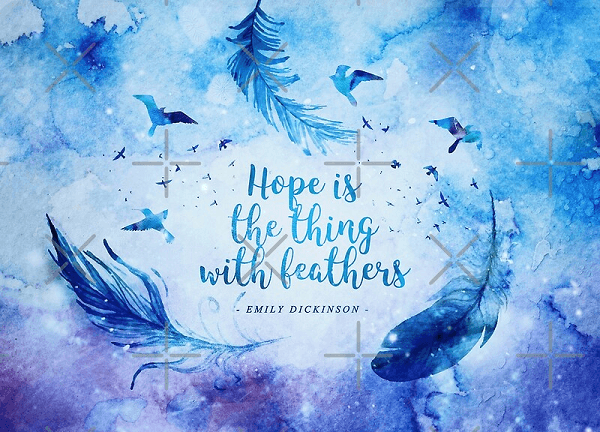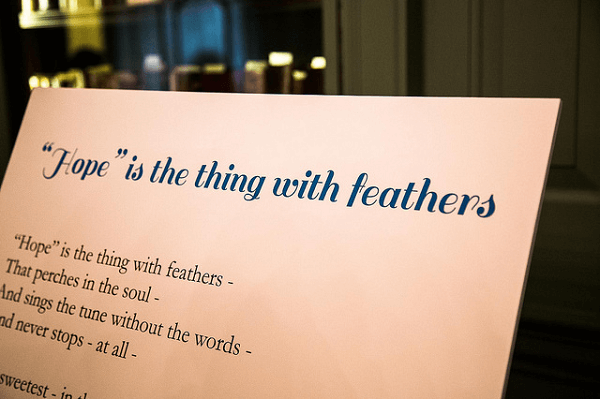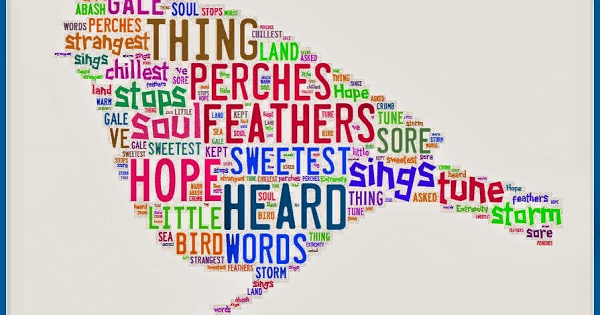Hope is the Thing with Feathers Summary"Hope is the Thing with Feathers" (written in 1861) is a good poem by American writer Emily Dickinson. In the poem, "Hope" is metaphorically changed into serious areas of strength for a bird that stays inside the human spirit and sings its melody come what may. The poem attempts to help perusers to remember the force of idealism and how little it requests from them. The speaker underlines that Hope has been helpful in difficult stretches and has never requested anything. "Hope is the Thing with Feathers" is one of Dickinson's poems that utilizations surprising symbolism and figurative language to rejuvenate a theoretical subject. 
SummaryDickinson's poem is a good exploration of Hope. The poem's speaker opens with the declarative statement, "'Hope' is the thing with feathers" (Line 1). This statement starts a lengthy representation where "Hope" is recommended as a bird. The speaker, nonetheless, doesn't make the equation straightforwardly. All things being equal, they propose the correlation in pieces and, at times, are equivocal. Regardless, they call 'Hope' [...] the thing with feathers." (Line 1). While it may not be clear what a "thing with feathers" (Line 1) is, the subsequent line's utilization of "perches" (Line 2) potentially gets a handle on that the speaker is looking at a bird. This bird, the speaker envisions, "perches in the spirit" (Line 2) rather than on branches and "sings the tune without the words" (Line 3). At the finish of the top verse, the speaker keeps up that the bird's melody "never stops - at all" (Line 4). 
Like the bird's tune, the last line of the top verse goes on all through the subsequent refrain. They describe the bird's singing as "sweetest" (Line 5) and argue that even "in the Gale" (Line 5), the melody can still be "heard" (Line 5). Like the bird's tune, the last line of The speaker then imagines a "sore [...] storm -/That could abash the little Bird" (lines 6-7). The storm is simply speculative, and after a short time, the speaker progresses toward acclaiming the bird's capacity to keep "so many warm" (Line 8). The main verse goes on all through the subsequent refrain. This prolonged warmth shows that the bird has weathered several storms. With the word "so many" (Line 8), the speaker further articulates that the bird signifies Hope in a pluralistic, abstract meaning. In the last refrain, the speaker differentiates the glow that finished the second verse with "the most chill land" (Line 9). The speaker gets back to the bird's melody and states that they hear the tranquil tune in both this "chillest land" (Line 9) and "on the strangest Sea" (Line 10). This quick overview of unfamiliar areas suggests that, similarly to the bird's tune "never stops" (Line 4), the bird never leaves the speaker's spirit. Given the similitude spread in the top line between "Hope" (Line 1) and the bird, it very well may be recognized that the speaker is similarly saying, in this last abstain, that Hope has never left them. This idea is somewhat affirmed by Line 11, where the speaker communicates that the bird has moreover been with them "in Furthest point" (Line 11) or faraway regions. Finally, that's what the speaker communicates "Hope" (Line 1), or the bird, has "never [...] asked a piece - of me" (Line 11-12). This last line recommends that the bird is self-supporting and requires nothing of the spirit it "perches in" (Line 2). Theme"Hope is the thing with feathers" is a praise poem designed to honor the human ability of Hope. The poem utilizes a lengthy illustration to portray Hope as a bird that stays inside the human spirit; this bird sings come downpour or sun, hurricane or storm, great times or terrible. The poem contends that Hope is amazing and nearly hard to overcome. Besides, Hope never requests anything; consequently ? keeping Hope costs nothing. Subsequently, "Hope is the thing with feathers" entreats its perusers to take full advantage of Hope ? and to remember it as a fundamental piece of themselves. The poem starts by laying out its critical similitude: Hope is a bird. It then enlightens the peruser about this bird, adding subtlety, before showing it in various circumstances. The poem closes by expressing that, regardless of all it does, hope never requests anything from the speaker. Generally speaking, then, at that point, the poem transforms Hope into a distinctive envisioned character to show how significant it is, both to people and to humanity all. 
In the poem, Hope is originally characterized as "the thing with feathers." However, this is a bird (as affirmed in line 7); the odd idea of this first portrayal shows that the writer believes the peruser should take a gander at home with an open-minded perspective and not underestimate it. Starting with "Hope is a bird" has the same precise meaning but appears significantly less surprising, and the sensation of surprise contributes to the poem's goal of redefining Hope. This "Hope" bird "roosts" in the spirit; it is Hope's home to show the true spirit. Hope is straightforwardly connected with the human soul, singing while never halting. This diligence, then, portrays humanity's endless limit concerning Hope. Indeed, even in the profundities of depression, the poem appears to say individuals can, in any case, have Hoped ? and this Hope will support them. Without a doubt, the bird sings "best" in the storm. All in all, Hope shows its significance amid affliction and appears to direct individuals through that misfortune. This point could apply to humanity's difficulties from an overall perspective, or it could connect with additional individual encounters like individual sadness and misfortune. Hope gives individuals the solidarity to continue, and it's most helpful when conditions are the best-case scenario. Of course, there are moments when individuals appear to lose their strength?but, as the poem says, optimism still plays a crucial role in these situations. The poem illustrates this by referring to a large number of individuals ("so many") who have been nourished by Hope, noting that only a genuinely "sore" "storm" could weaken "the little Bird." Hope, it appears, can keep individuals "warm" even in dire circumstances. And, despite the importance of Hope in human existence, the beauty of it, according to the poetry, is that it needs almost few people. Hope is free, not even a "crumb"?yet it may physically and metaphorically keep people alive. People can endure the worst circumstances if they have Hope?all they have to do is listen to "the little Bird" and sing its melody. Overall, "Hope is the thing with feathers" encourages people to appreciate their ability to hope?and to recognize that it is never truly lost. Without getting too specific, the poem argues that Hope may be especially useful in the most dire circumstances and that people should thus rely on it as a valuable resource.
Next TopicI Have a Dream Speech Summary
|
 For Videos Join Our Youtube Channel: Join Now
For Videos Join Our Youtube Channel: Join Now
Feedback
- Send your Feedback to [email protected]
Help Others, Please Share









